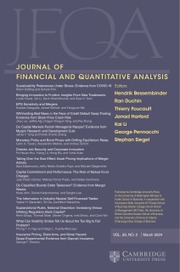Crossref Citations
This article has been cited by the following publications. This list is generated based on data provided by
Crossref.
Sakemoto, Ryuta
2022.
Risk Premium Decomposition and the Output Gap.
SSRN Electronic Journal ,
Liu, Yu
Zhang, Zhengchao
Jing, Xin
Yang, Yawen
and
Khattak, Hasan Ali
2022.
The Effectiveness Evaluation Model of the Conversion of New and Old Kinetic Energy in the Cloud Computing Environment.
Mobile Information Systems,
Vol. 2022,
Issue. ,
p.
1.
Zhu, Lin
Jiang, Fuwei
Tang, Guohao
and
Jin, Fujing
2023.
The Sword of Damocles: Sparse Macroeconomic Risks and the Cross-section of Stock Returns.
SSRN Electronic Journal,
Zaremba, Adam
Cakici, Nusret
Bianchi, Robert J.
and
Long, Huaigang
2023.
Interest rate changes and the cross-section of global equity returns.
Journal of Economic Dynamics and Control,
Vol. 147,
Issue. ,
p.
104596.
Su, Chen
2023.
The price impact of analyst revisions and the state of the economy: Evidence around the world.
Financial Review,
Vol. 58,
Issue. 4,
p.
887.
Dang, Thuy Duong
Hollstein, Fabian
and
Prokopczuk, Marcel
2023.
Factor Pricing Across Asset Classes.
SSRN Electronic Journal,
Ni, Yensen
Chiang, Pinhui
Day, Min-Yuh
and
Chen, Yuhsin
2023.
Using Big Data Analytics and Heatmap Matrix Visualization to Enhance Cryptocurrency Trading Decisions.
Applied Sciences,
Vol. 14,
Issue. 1,
p.
154.
Iwanaga, Yasuhiro
and
Sakemoto, Ryuta
2023.
Cross-momentum strategies in the equity futures and currency markets.
SSRN Electronic Journal,
Bengitöz, Pelin
and
Umutlu, Mehmet
2023.
Are return predictors of industrial equity indexes common across regions?.
Journal of Asset Management,
Vol. 24,
Issue. 5,
p.
396.
Shirokawa, Hiroaki
Yamaguchi, Kohei
Obata, takahiro
and
Sakemoto, Ryuta
2023.
Swaption and term structures of volatility risk premiums.
SSRN Electronic Journal,
Long, Huaigang
Chiah, Mardy
Zaremba, Adam
and
Umar, Zaghum
2024.
Changes in shares outstanding and country stock returns around the world.
Journal of International Financial Markets, Institutions and Money,
Vol. 90,
Issue. ,
p.
101883.
Iwanaga, Yasuhiro
and
Sakemoto, Ryuta
2024.
Cross-momentum strategies in the equity futures and currency markets.
Journal of International Money and Finance,
Vol. 148,
Issue. ,
p.
103170.
Nayar, Nandkumar
Price, S. McKay
and
Shen, Ke
2024.
Macroeconomic Uncertainty and Predictability of Real Estate Returns: The Impact of Asset Liquidity.
Journal of Real Estate Research,
Vol. 46,
Issue. 1,
p.
82.
Xin, Ling
2024.
Short-term contrarian in the carbon emission market.
Energy Economics,
Vol. 139,
Issue. ,
p.
107903.
Zhu, Lin
Jiang, Fuwei
Tang, Guohao
and
Jin, Fujing
2024.
From macro to micro: Sparse macroeconomic risks and the cross-section of stock returns.
International Review of Financial Analysis,
Vol. 95,
Issue. ,
p.
103433.
Eldomiaty, Tarek
Azzam, Islam
Fouad, Mostafa
and
Said, Yasmeen
2024.
The Use of Economic Indicators as Early Signals of Stock Market Progress: Perspectives from Market Potential Index.
International Journal of Financial Studies,
Vol. 12,
Issue. 1,
p.
21.
Sakemoto, Ryuta
2025.
Risk price decomposition and the output gap.
Financial Review,
Vol. 60,
Issue. 1,
p.
121.
Sakemoto, Ryuta
2025.
Time‐varying group common factors in the stock market anomalies.
Financial Review,
Vol. 60,
Issue. 2,
p.
481.
Fieberg, Christian
Liedtke, Gerrit
Zaremba, Adam
and
Cakici, Nusret
2025.
A factor model for the cross-section of country equity risk premia.
Journal of Banking & Finance,
Vol. 171,
Issue. ,
p.
107373.
Ma, Tian
and
Wang, Yuejie
2025.
Global Integration, Culture and Cross-Market Factor Momentum.
Emerging Markets Finance and Trade,
p.
1.


